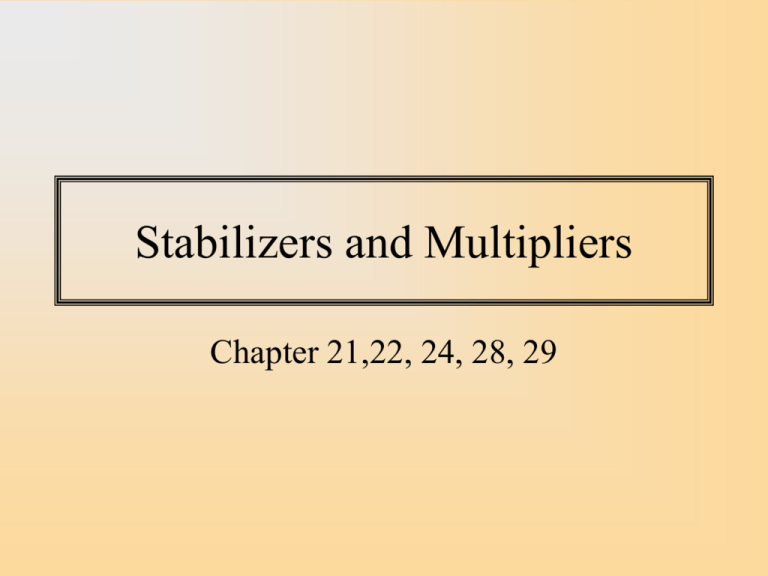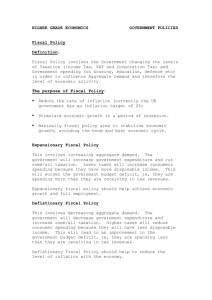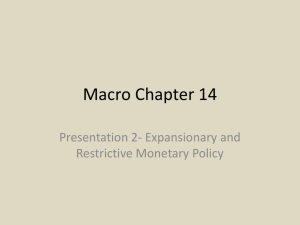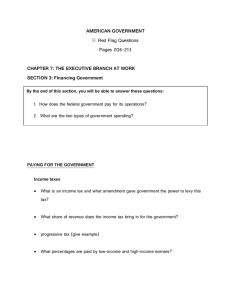Supply and Demand
advertisement

Stabilizers and Multipliers Chapter 21,22, 24, 28, 29 Consumption and Investment Expenditure are Sensitive to the Business Cycle • Multiplier Effect: When household income increases, household consumption will also increase. • Financial Accelerator Effect: Download When business cycle conditions improve, business cash flow also improves. Businesses, especially those without access to financial markets, rely on cash flow for financing. Expenditure is a Feedback Loop • Consumption and Investment Expenditure are determined by household and corporate income. • Income is determined by the value added of output in the economy. • Output (at a given wage level) will be determined by demand for expenditure. Multiplier Effect Production Consumption Income Savings Multiplier Effect 2 Production Consumption Income Savings Multiplier Effect 3 Production Consumption Income Savings Multiplier Effect in the Open Economy • Multiplier feedback is moderated by international trade. • Some of the extra expenditure generated by extra income/cash flow will be spent on imports and thus not generate extra demand for domestic goods. • Multiplier effect smaller in economies that spend a high fraction of their income on imported goods. Multiplier Effect: Open Economy Production Consumption Income Imports Savings Investment & Business Cycles • Corporate & residential investment tends to be one of the most pro-cyclical economic variables though rising real rates during boom may tend to ameliorate these effects. • Reasons: – Investment may be a driver of business cycles due to animal spirits or advances in technology. – Financial Accelerator Effect Stabilizers Monetary Policy Channel of Monetary Policy • When the central bank increases the monetary base, the money supply will increase. • Banks have excess liquidity which they use to make more loans. • The supply of liquidity will exceed demand and banks must compete to attract borrowers who will hold this liquidity only at a lower interest rate. Dynamics of Monetary Transmission • Money supply expansion reduces interest rates • Lower interest rates implies an increase in borrowing and affects demand for interest sensitive goods. • Lower interest rates increase demand for US$ in forex market depreciating the exchange rate. • Aggregate demand shifts out. Given fixed input prices this increase in demand stimulates output. Monetary Transmission Mechanism ECB Web Site Expansionary Monetary Policy P ΔI ΔC, ΔNX AD AD′ Y An Expansionary Cycle Driven by monetary policy 2. Monetary Policy Cuts Interest Rate YP P 3 1. Economy at LT YP. SRAS 3. Investment rises. The AD curve shifts out. 2 P* 1 AD′ AD Output Gap Y 4. Tight labor markets. SRAS returns to long run equilibrium Interest Rate Management • In most economies around the world, the central bank does not simply act to maintain a fixed money supply. • Rather, they adjust money supply to maintain and manage interest rate changes in response to business cycle conditions. Monetary Policy • In the US (and Euroland and Japan and most OECD economies), the central bank sets monetary policy by picking a short-run interest rate they would like to prevail. • In HK, the central bank sets monetary policy by picking a fixed exchange rate. U.S. Central bank cuts interest rates during recessions Demand Driven Recession w/ Counter-cyclical monetary policy YP P 2 P* SRAS 2. Monetary Policy Cuts Interest Rate 1 AD′ Y* Recessionary Gap 1. Economy in a recession. Fed detects deflationary pressure AD Y 3. Investment increases spending to shift the AD curve back to long run equilibrium Demand Driven Expansion w/ Counter-cyclical monetary policy YP P 2. Monetary Policy Raises Interest Rate SRAS 1 P* 2 AD AD′ Inflationary Gap 1. Economy in expansion. Fed detects inflationary pressure Y 3. Investment decreases spending to shift the AD curve back to long run equilibrium Taylor Rule • Economist named John Taylor argues that US target interest rate is well represented by a function of 1. current inflation 2. Inflation GAP: current inflation vs. target inflation 3. Output Gap: % deviation of GDP from long run path • Function: Inflation Target π* = .02 TGT t i .025 t 1 ( t ) 1 2 Output Gapt * 2 The Taylor Rule Download What should be the current Fed Funds rate? Will they be increasing it soon? • Step 1. Find Inflation Rate • Step 2. Find Output Gap • Step 3. Calculate Taylor Rule implied rate and compare with current rate. Answer P_2008_2 P_2007_2 Inflation Y YP Output Gap Inflation Gap Taylor Rule Fed Funds Rate 121.91 120.00 0.016 11740.3 11904.0 -0.014 -0.004 0.032 0.02 US Recessions are becoming shorter as stabilization policies were adopted. Average Length of Contraction 25 Months 20 15 10 5 0 1854-1919 1919-1945 1945-2001 Fiscal Policy Sources of Revenue HK 2004/2005 Land Premium & Sales 20% Profit Tax 24% Investment Income 10% Betting, Fees, Duties 25% Salaries Tax & Property, Other 21% HK Government Outlays by Category 2005/06 Support 12% Community Affairs Economic 3% 6% Social Welfare 14% Education 22% Security 10% Infrastructure 10% Environment and Food 4% Housing 6% Health 13% Fiscal Policy • The government directly controls its own expenditure and can thereby directly affect aggregate demand. • The government controls the tax levels and therefore they can indirectly impact the spending of households that pay taxes. – Expansionary policy: Increase spending, cut taxes. – Contractionary policy: Decrease spending, raise taxes Stabilization policy • In an economy subject to shocks to aggregate demand (animal spirit shocks, external shocks, asset market shocks), the economy will have a self-correcting mechanism. • However, if this self-correction mechanism takes a long time to work, then government may use policy to speed adjustment. – Use expansionary policy to close a recessionary gap – Use contractionary policy to close an inflationary gap Demand Driven Recession Counter-cyclical fiscal policy YP P 3 P* 1 2 Y* Recessionary Gap SRAS w/ 1. Economy in LT equilibrium 2. Demand shifts in 3. Government increases AD spending to shift the AD curve back AD′ Y Demand Driven Expansion Counter-cyclical fiscal policy YP P SRAS 1. Economy in LT equilibrium 2. Demand shifts out 2 P* 3. Government cuts spending to shift the AD AD′ curve back 1 3 Y* w/ AD Inflationary Gap Y Lags and Fiscal Policy • Administrative lags for fiscal policy may likely be large. • Except in absolute dictatorships, government will have mechanisms for building a consensus for expenditures. Adjusting this consensus will be time consuming. • If lags are too long, stabilizing government spending or transfer payments may have a destabilizing effect, shifting out demand after the economy has already recovered. Automatic Stabilizers • Taxes are usually collected as a fraction of incomes of households. Even if the government keeps the tax rate unchanged. – When the economy goes into a boom, taxes are automatically raised mitigating the effects of the boom. – When the economy goes into a recession, taxes are automatically cut, ameliorating the recession. Budget Deficit • Governments in most economies issue debt to make up for shortfalls in revenues in relation to spending. Budget Deficit = Expenditures – Taxes • Tax collection is cyclical so the budget deficit tends to be counter-cyclical. • Maintaining a balanced budget over the cycle means raising taxes in a recession an cutting taxes in a boom which makes the business cycle more extreme. Procyclical Budget Surplus in HK .12 .08 .04 .00 -.04 -.08 1990 1992 1994 1996 1998 2000 2002 2004 2006 Budget Surplus (as a % of GDP) Detrended GDP Turkey Thailand Singapore Poland Peru Mongolia Israel India Cote d'Ivoire Chile Botswana Belarus Albania 180 160 140 120 100 80 60 40 20 0 % Most Economies Have Positive Government Debt. Debt/GDP Why would a persistent deficit be a problem? Two Reasons 1. High government borrowing may push up interest rates and crowd out investment 2. High government borrowing means that the interest obligations of the government will rise. -1.00% -2.00% -3.00% -4.00% -5.00% -6.00% -7.00% 1995 1994 1993 1992 1991 1990 1989 1988 1987 1986 1985 1984 1983 1982 1981 1980 1979 1978 1977 1976 1975 Budget Surplus in USA (as a % of GDP) 0.00% Government Interest Payments per US Resident $1,000.00 $900.00 $800.00 $600.00 $500.00 $400.00 $300.00 $200.00 $100.00 1995 1994 1993 1992 1991 1990 1989 1988 1987 1986 1985 1984 1983 1982 1981 1980 1979 1978 1977 1976 $0.00 1975 1996 US$ $700.00 Hong Kong Has Traditionally had negative Debt. Government Wealth 800000 700000 600000 500000 400000 300000 200000 100000 19 86 19 87 19 88 19 89 19 90 19 91 19 92 19 93 19 94 19 95 19 96 19 97 19 98 19 99 20 00 20 01 20 02 20 03 0 Question: Problem with Central Bank Stabilization • Situation: Economy is in long-run equilibrium, but central bank overestimates potential output. • Draw outcome if central bank believes that the potential output is higher than it is. Learning Outcomes Students should be able to: • Explain the effect of business cycles on different components of expenditure • Use the Taylor rule to calculate a forecast of U.S. interest rates. • Explain the uses of counter-cyclical monetary and fiscal policy in stabilization. • Explain the effect of budget deficits on real interest rates on capital markets. • Explain the negative effects of long-term budget deficits.








